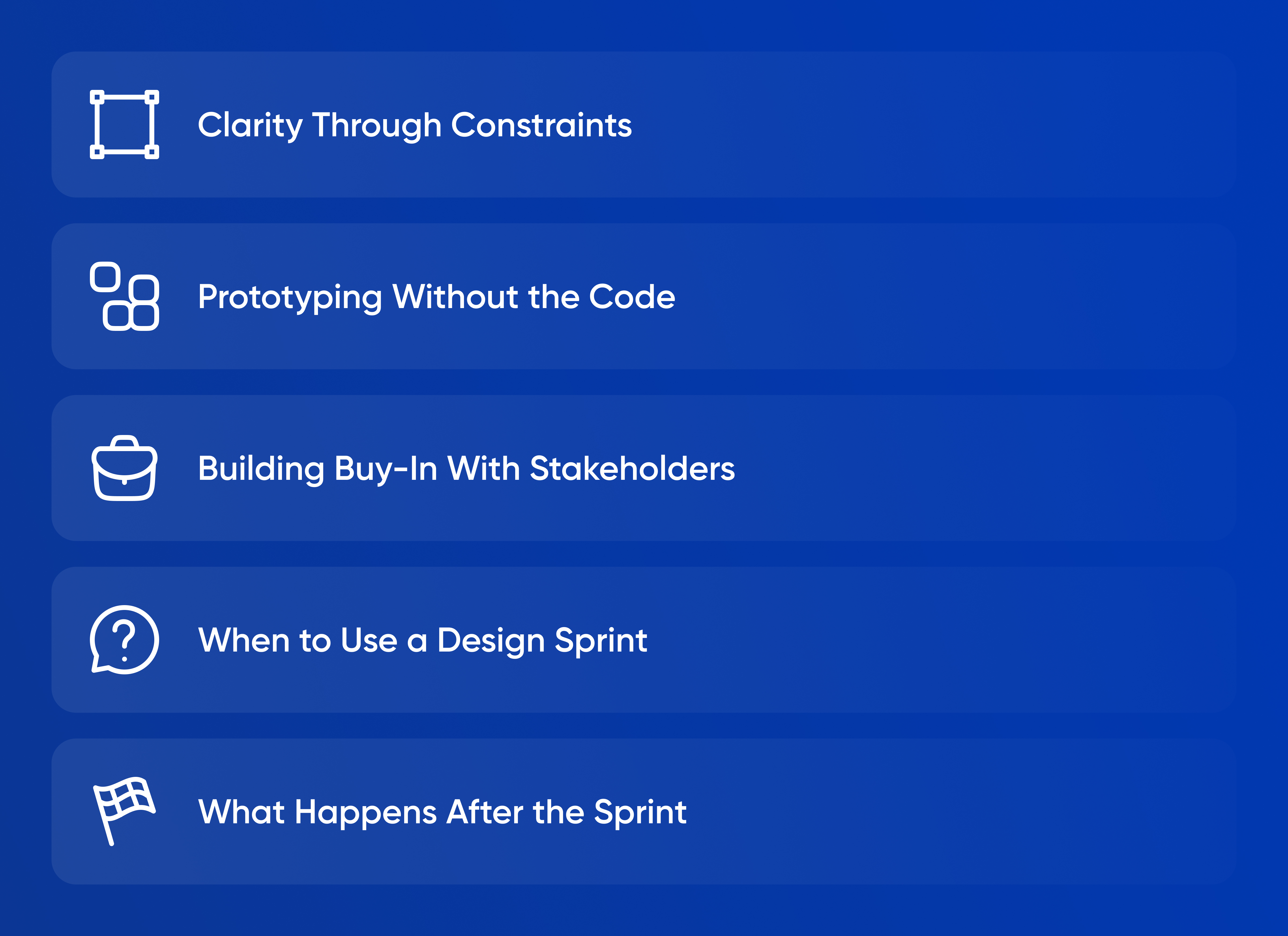The hardest part of launching a new product isn’t building it. It’s knowing what to build.
For early-stage startups operating under intense pressure and limited time, the need to validate ideas quickly is critical. You don’t want to spend months and thousands of dollars building a feature set that users didn’t ask for. What you need is a fast, structured way to turn ambiguity into clarity, align your team, and test a real solution — all within days.
Enter the design sprint. Originally developed by Jake Knapp at Google Ventures, the design sprint is a five-day process that helps teams rapidly ideate, prototype, and test ideas with real users. It’s not about guessing. It’s about learning — fast.
For founders, especially those without a technical background, design sprints offer a shortcut to product confidence. They allow you to skip long debates and endless planning cycles and instead put a realistic version of your idea in front of users — before a single line of production code is written.
At Movadex, we often run design sprints with clients who are facing one of three challenges: launching a new product, deciding between competing features, or preparing for an investor pitch. In every case, the sprint delivers clarity and momentum. Let’s explore how.

Clarity Through Constraints
One of the reasons design sprints are so effective is because they impose structure. Unlike traditional brainstorms or open-ended product planning, a sprint has a clear beginning, middle, and end.
Day 1 is about mapping the challenge and setting a long-term goal. What are we trying to achieve? What problem are we solving? Who are we solving it for?
Day 2 is about sketching ideas individually — not as a group. This eliminates groupthink and ensures everyone’s creativity has space to surface.
Day 3 focuses on decision-making. The team reviews sketches, votes on the strongest ones, and creates a storyboard of the prototype.
Day 4 is build day. The prototype doesn’t need to be perfect — it just needs to look and feel real enough to get user feedback.
Day 5 is test day. You put the prototype in front of 5 real users. You observe. You learn. You pivot or proceed with confidence.
For a startup that might otherwise spend months in product limbo, five days can change everything.
Prototyping Without the Code
A powerful part of the sprint is how it separates user insight from engineering. You don’t need to build a working product to validate if an idea is directionally right. Instead, you create a high-fidelity prototype using tools like Figma or InVision. These clickable designs mimic the real experience, giving users a clear sense of what your product could be.
This method is not just fast — it’s cost-effective. You avoid the trap of building complex backends or full apps before you’ve validated demand.
For early-stage startups, this approach can mean the difference between a strategic pivot and a costly rewrite. The prototype becomes a conversation starter, a tool for investor meetings, and a compass for your next development sprint.
Building Buy-In With Stakeholders
In addition to speed, design sprints help align teams and investors. Startups are often chaotic. Founders, designers, engineers, and advisors may have different ideas about what matters most. The sprint forces alignment through action.
By the end of Day 5, everyone involved sees the same prototype and has watched the same user feedback unfold. Assumptions get tested — not debated. Biases get exposed. And because the process includes voices from different functions, the outcome usually feels more collaborative and robust.
If you’re preparing to pitch your idea or secure funding, the outputs of a design sprint — from the user journey map to the final prototype — can become powerful artifacts. Investors love seeing that a team has taken time to de-risk an idea through real-world feedback.
When to Use a Design Sprint
Design sprints aren’t just for new product ideas. They can be useful at multiple stages of your startup journey.
If you’re pre-MVP and need to explore potential directions, a sprint gives you structure to move from a blank page to a real prototype.
If you already have an MVP but are stuck on what to build next — or facing churn and unclear product-market fit — a sprint can refocus your team and uncover hidden user pain points.
Even post-funding, sprints help prioritize features, explore pricing strategies, or redesign onboarding to improve activation.
At Movadex, we often recommend a sprint any time the team is facing a high-stakes decision and wants to move quickly, but thoughtfully. It’s the perfect blend of agility and rigor.
What Happens After the Sprint
A sprint doesn’t end with a perfect solution. It ends with data. You’ll know which parts of your idea resonate with users — and which ones don’t. This insight informs your roadmap and ensures your development efforts are grounded in evidence.
After the sprint, most startups either:
-
Go straight into MVP development, using the prototype as the blueprint.
-
Run a second sprint to refine the concept or test another solution.
-
Combine insights from the sprint with market data to prioritize their next investment.
In all cases, the sprint compresses what might have taken 3–4 months into a single week — without sacrificing quality.
Final Thought: Time is Your Most Valuable Asset
Startups don’t fail because they run out of money. They fail because they run out of time — building the wrong thing, chasing the wrong user, or getting stuck in internal debates.
Design sprints offer a way out of that spiral. They create clarity, momentum, and focus. They shift your product process from guesswork to grounded thinking. And they remind every founder that the fastest way to build something great is to start by learning what people truly need.
If you’re unsure about your next move, a sprint might be the smartest five-day investment you’ll ever make.




